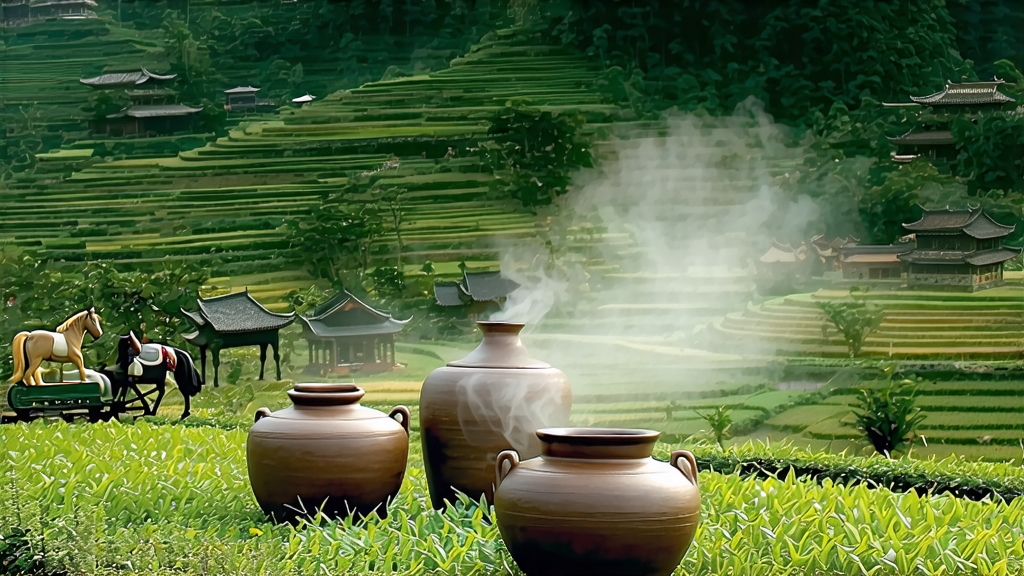
Tucked into the southern folds of China’s Guangxi Zhuang Autonomous Region, the small town of Liubao has given the world a tea that travels through time as effortlessly as it once traveled along the Tea Horse Road. Liu Bao—literally “Six Forts”—is the least internationally famous yet arguably the most aromatically distinctive member of the dark-tea family. While Pu-erh hogs the limelight, Liu Bao quietly ages in terracotta jars, acquiring the scent of betel nut, damp camphor and autumn orchards, waiting for the moment its story is told in a language other than Chinese. This is that moment.
A FRACTURED HISTORY IN SEVEN ACTS
- Song dynasty border guards brew coarse leaves to calm dysentery.
- Ming imperial clerks list “Liubao” as a tribute item, levying 150 dan annually.
- Qing caravans carry it through Guangdong’s Pearl River Delta to Hong Kong, then onward to Malaya where tin-mine coolies swear it prevents malaria.
- 1937: war chokes the mountain passes; tea sits in humid storerooms, accidentally “wet-piled” decades before the technique has a name.
- 1958: state-owned Wuzhou Tea Factory standardizes the pile-fermentation room, borrowing Liu Bao’s accidental discovery to create ripe Pu-erh.
- 1973: a container bound for Kuala Lumpur is forgotten on the dock; when opened three monsoons later, the tea inside glows like black amber—collectors swoon.
- 2020: a single 500 g tong of 1950s “Songpin” Liu Bao sells at auction for USD 42,000, outbidding a Dalmore 62 whisky lot.
THE MICRO-TERROIR BEHIND THE MACRO-FLAVOR
The Liu Bao micro-region sits at 23–24 °N, 110–111 °E, where the subtropical monsoon collides with the granite spine of the Da Yao Shan. Daytime humidity hovers at 85 %, nighttime temperature drops 12 °C, coaxing the tea bush (a sinensis-assamica hybrid locally called “medium-leaf big-bud”) to produce an unusually thick cuticle. The soil is lateritic, rich in iron and kaolin, imparting a subtle metallic tang that later translates into the tea’s signature “iron note”—a fleeting sensation on the tip of the tongue reminiscent of licking a wet river stone.
FROM LEAF TO DARK MATTER: THE CRAFT
Harvest: One bud and the fourth or fifth leaf—what farmers call “lao ye” (old leaf)—is plucked from late April to mid-May when amino acids have dipped and lignin has risen, ensuring the leaf can withstand the coming microbial onslaught.
Withering: 6–8 hours on bamboo racks inside a ventilated shed; leaf temperature is not allowed to exceed 34 °C, preserving indigenous yeasts.
Fixation: A 90-second tumble in a 280 °C drum halts oxidation but deliberately under-kills the leaf enzymes, leaving a 12 % residual activity that will feed the pile.
Rolling: 40 minutes of light pressure twists the leaf into thick cords without rupturing too many cell walls; this slows subsequent fermentation and allows decades of micro-aeration.
Pile-Fermentation: The leaf is heaped 70 cm high inside a pine-bark room kept at 28 °C and 80 % RH. Every seven days the pile is turned; water is misted to maintain 30 % moisture. Thirty-five days later the leaf has turned walnut-brown and smells of jackfruit and wet joss paper.
Drying: Sun-drying is forbidden—the Guangxi sun is too fickle—so the tea is basket-fired over low-temperature charcoal (50 °C) for ten hours, reducing moisture to 10 % and adding a whisper of smokiness.
Sorting & Compression: Broken leaves become “tea-dragon” (long cha) for immediate consumption; intact strips are steamed for three seconds, pressed into 50 kg wicker baskets lined with bamboo leaf, then stacked seven high in a humidity-controlled warehouse for a mandatory two-year “rest” before market.
Aging: Ideal vessels are unglazed Guangdong clay jars whose micropores breathe at 0.2 ml O₂ per day. A 20-year vertical tasting shows